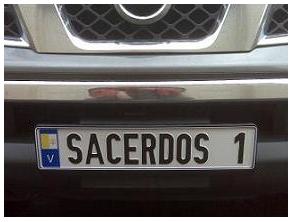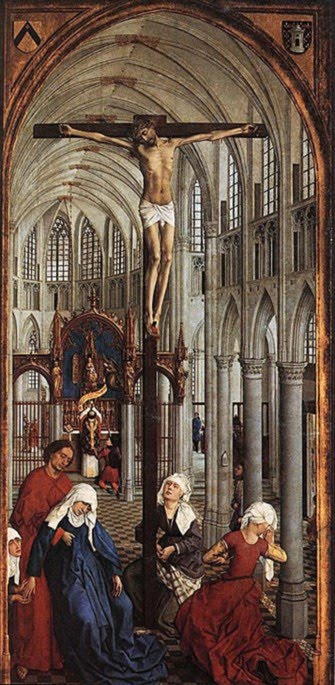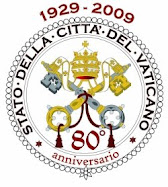
Wednesday, August 14, 2013
More Thoughts on "Ad Orientem" Celebration of the Eucharist...
A Blog post that a parishioner recently forwarded to me, from Msgr. Charles Pope at the Archdiocese of Washington (Link is HERE). Here's the full text of the post:
Some years ago the theologian Fr. Jonathan Robinson wrote a commentary on the modern experience of the Sacred liturgy and entitled it, The Mass and Modernity: Walking to Heaven Backward. It is a compelling image of so much of what is wrong with the celebration of the Liturgy in many parishes today.
While Fr. Robinson certainly had the celebration of Mass “facing the people” in mind, his concerns are broader than that.
Indeed, we have the strange modern concept of the “closed circle” in so many modern conceptions of the Mass. Too often we are tediously self-referential and anthropocentric. So much of modern liturgy includes long lists of congratulatory references, both done by, but also expected of the celebrant.
Instead of the Liturgy being upwardly focused to God and outwardly toward the mission of the Church (to make disciples of all the nations), we tend today to “gather” and hunker down in rather closed circles looking at each other, and speaking at great length about ourselves.
We have even enshrined this architecturally in our modern circular and fan shaped churches that facilitate us looking at each other, and focusing inwardly, not up or put. The author Thomas Day once described Modern Catholic Liturgy as, “the aware, gathered community celebrating itself.” [1]
In the ancient orientation or “stance” of the Mass that was ubiquitous until 1965, the focus was outward and upward. Though disparaged by many in recent decades as the priest “having his back to the people” even this description shows the self obsession of the modern age. And to those speak this way about the liturgical orientation of almost 2,000 years, the answer must come, “The priest does not have his back to you. Actually it is not about you at all. The liturgy is about God. And the priest, and all the faithful are turned outward and upward to God.”
The liturgical questions of the history of the eastward orientation and its recent loss, of how and why we got into the modern closed circle mentality, and the erroneous understandings of the liturgists of the 1950s about the practice of the early Church, are all discussed more aptly by others more liturgically versed than I.
Please consider dear reader that my proposal is not for a sudden and swift change in our liturgical stance. Rather, that we begin to ponder if, by our inwardly focused stance in circular and fan shaped churches, facing each other, we are communicating what we really intend. Does our stance project that our real focus here is God? Does it communicate the goal of the liturgy to lead us to God? Does it inculcate a spirit of leadership in our clergy who are called to lead us to God? Does a largely closed circle manifest an outward trajectory to evangelize outward and unto the ends of the earth?
Whatever pastoral blessings come with “facing the people” (and there are some blessings) there may be value in continuing to reassess whether our modern pastoral stance of an inwardly focused liturgy serves us well and communicates what we are really doing and experiencing.
I would like to link the current “closed circle” liturgical experience to another struggle of Church life today: the crisis of leadership. Many of the lay faithful have come to decry the crisis of leadership among the clergy. And while there are excesses in way these concerns are expressed (according to me), there is surely a grave hesitancy on the part of too many clergy to lead. Too rare are clergy today who point to God and the will of God in clear and unambiguous terms. Too many of us prefer to speak in abstractions and generalities. I do concur that we have experienced so degree of a crisis in leadership. There are notable exceptions to this problem, but it remains a widespread issue. And of course the primary place that the faithful ought to experience leadership is in the sacred Liturgy, where the clergy unambiguously point to God and lead others to Him.
But the stance of the Liturgy as a kind of closed circle does not easily support this sort of thinking.
To be sure, there are many reasons for the current crisis of leadership in the Church. Surely the overall crisis of manhood in our culture, along with passive or missing fathers is a central cause. Also related is the rise of feminism and the designation of normal male tendencies to competition and leadership as “pathological” and misogynist. Many normal school boys, full of spit and vinegar, and a tendency to rough-house are “diagnosed” and medicated, and told explicitly to behave more like girls.
There are also modern tendencies that are unreasonably hateful or suspicious about power and the use of authority, along with a kind of hyper-vigilance not to offend, and to be obsessed with how others “feel” about things. And while “getting along” with people and being respectful of their feelings are good dispositions in themselves, they are not absolute virtues and must sometimes be set aside for the higher good of pointing to the truth of God and insisting on it.
Hence, there are many factors that have fed the crisis of the leadership among the clergy. But I propose that liturgical orientation is both emblematic of the crisis of leadership and also fuels it.
While a priest is called to love his people, speak to their hearts and even to learn form them, he is most especially tasked to lead them to God. And while, in the Liturgy of the Word, it makes sense that he turns to them to instruct and engage them, there ought to be a moment when he turns to God and leads his people toward God.
The Eucharistic Prayer is surely this time. As priest, he leads. Acting in persona Christi, he leads the people, (for Christ said, “follow me”) out to Calvary, to the death and resurrection, to new Life. In this Jesus, acting through the priest, also leads back to the Father. He is leading us somewhere.
But leaders do not walk backward facing their followers. They are out front, at the head of the procession. One of the Collects of the Breviary asks that the humble flock may reach where the brave Shepherd has gone before.
But there is usually very little sense of leadership in the current liturgical environment. There seems the unspoken demand that the leader, our celebrant, focus on us, rather than God. His job is to please and enrich us, rather than point to God and insist that we follow. Leadership suffers under this kind of expectation of “enriching” and affirming, rather than summoning to discipleship and pointing unambiguously to God.
The direction of the Liturgy should be an “onward and upward” trajectory. But too often today it is inward, and it is difficult to perceive a motion upward to God or outward to evangelization.
I realize that a post like this will generate considerable controversy. But remember that this is only a discussion. I do not argue for sudden or radical shifts in our liturgical stance, only that we should continue to discuss it and explore various options. I am only a priest, not a bishop and I do not argue that priests act independent of their bishop in significant matters such as this. Further, some settings are better for a change of stance than others. Great pastoral discretion is required in matters like these.
Neither do I argue for a return to Mass wholly facing the altar as was done in the past and still often is in the Extraordinary form. The Liturgy of the Word is authentically directed to the people of God for their edification, instruction and attention. It ought to be proclaimed to and toward them, as is fitting to its purpose and end. But the Eucharistic Prayer is directed to God, and not the celebrant is leading the faithful on procession to God. St. Augustine often ended the his sermon and the Liturgy of the Word by saying, “Let us turn to the Lord” and he then went up to the altar, facing it and leading the people to God.
So this is a discussion, that is all. And I pray it be conducted with mutual charity and, I might add, brevity. For while I heartily endorse the discussion of the Sacred Liturgy, it has well been observed that we Catholics run the risk of being so focused on what goes on inside Church that we lose any focus on the mission of getting outside and evangelizing! It would be ironic indeed and a countersign if, in arguing that our liturgy is too inwardly focused, that we who agreed or debated spent too long focused “inwardly” discussing the problem. Truth be told, Liturgy debates sometimes use up too much oxygen!
So have at it. And remember the focus of this post is not merely liturgical. Rather what I am pondering is how well our liturgical stance reflects and supports what should be our pastoral stance.
Subscribe to:
Post Comments (Atom)

































No comments:
Post a Comment